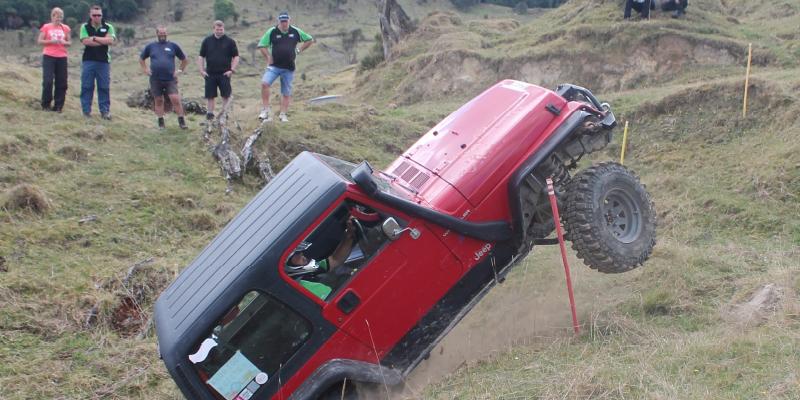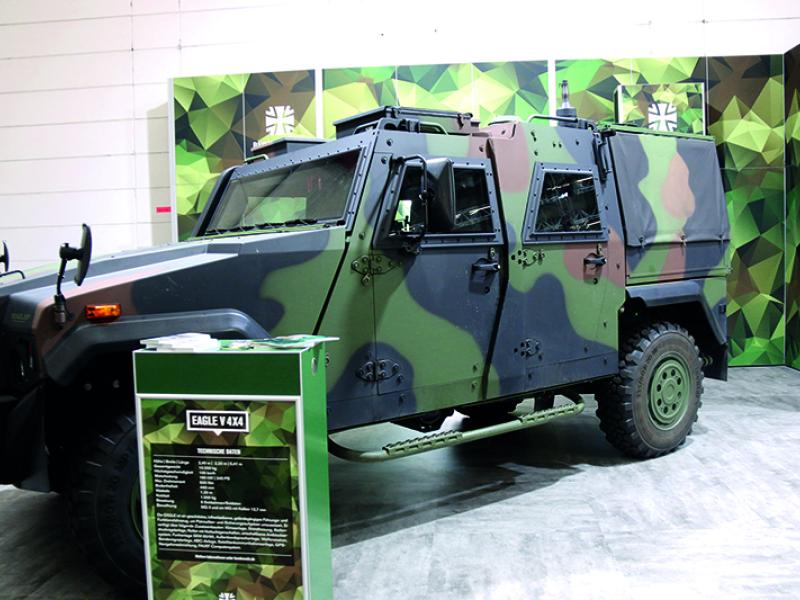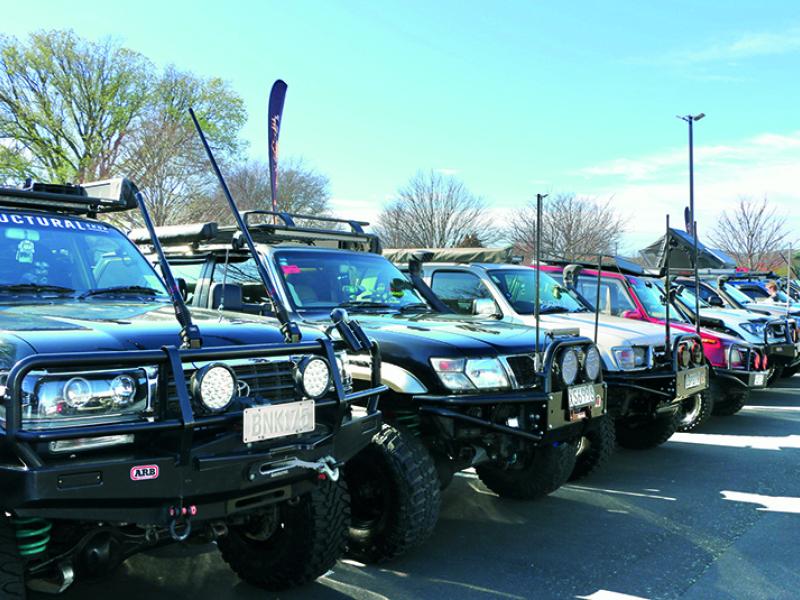There’s a place for everyone with a hi/lo ratio 4WD recreational vehicle in the Central Zone Club Truck Challenge,l as
Andrew Gee explains.
The Club Truck Challenge (CTC) is a competition run in the same way as 4x4 Trials or the Suzuki Extreme 4x4 Challenge. You are scored on your progress through short driving tests that are designed to be impossible.
Any variation of 4WD vehicle with low ratio is allowed to compete in the CTC provided that the vehicle is registered and has a WOF. To keep the playing field level there are four classes to let you better compete against similarly capable machines.
These classes are divided by traction control device and level of modification i.e.
• Class 1: Open differentials/no traction aids.
• Class 2: Non-controlled tractions aids like auto lockers or limited slip diffs.
• Class 3: Controlled traction aids or limited slip diffs.
• Class 4: Adjustable traction aids.
The engine is largely free and not an important consideration in the class rules. That shows that traction is the most important factor in this competition not power, although watching a Chevy engine throwing dirt on a hillclimb never grows old. Suspension is also largely free and gives mad scientists a chance to build something different from everybody else.
The remaining main determinant is maximum tyre size; in Class 1and 2, it is limited to 33-inch and in class 3 and 4 up to 35 inch tyres are allowed.
Past masters
A look over past results will show that a modified wagon is not necessary to do well. Dave McGinnity and Mark Smith in Class 2 Jeeps, Brendan Watchorn in a Class 2 Pajero, Alan Stone in a Class 2 Cruiser and Ross Gregory in a Class 1 Jeep have all taken overall wins over the years. All that is required is that you take part and drive well.
Stay classy
Class 1 Standard (Typically: Judith Hintz/Suzuki Vitara, Ross Gregory/Jeep CJ 4, Matt Liang/Nissan Patrol).
Class 1 can be considered as a ‘Standard’ class where a vehicle can only have an open differential. The vehicles are very wide ranging from Judith Hintz’s Suzuki Vitara, Matt Laing’s Nissan Patrol to Ross Gregory’s Jeep.
Judith’s Suzuki doesn’t even have a suspension lift and it can be seen in photos lifting wheels because it doesn’t have a lot of down travel in its suspension. The Vitara is a good light vehicle and easy to drive which gives Judith a lot of options when she chooses a line through a hazard.
Ross’s Jeep is all home made as suits an old vehicle without any aftermarket accessories available for it. It is very light because of its minimal body work and absence of window glass. The Jeep’s mid length wheelbase and good articulation lets it flex well in a hazard, for any other situation Ross just hits it with speed.
Meanwhile Matt Liang’s unmodified Nissan Patrol shows that most modern vehicles with suitable tyres can go anywhere.
Class 2 Limited Modified (Typically: Dave McGinnity/Jeep Wrangler TJ, Mark Smith/Jeep Wrangler TJ, Alan Stone/Toyota Land Cruiser FJ70, Mark Watchorn/Mitsubishi Pajero Gen 1, Brendan Watchorn/Mitsubishi Pajero Gen 2.)
Class 2 is known as Limited Modified and is a popular choice with drivers relying on diffs that can’t be locked by the driver; i.e. limited slip diffs and automatic lockers are allowed. That’s a good option when driving through the hazard, not having to switch in a locker and hoping it will engage or disengage when you need it.
Shona and Alan Stone’s Cruiser FJ70 is fairly standard but rugged enough to hit hazards without care. Another popular choice is the Mitsubishi Pajero Gen 2 which have become numerous in clubs because of their reasonable cost and easy availability compared to a Nissan Patrol GQ.
The Pajero is able to run a large tyre without too much alteration and has independent front suspension for some variation.
The Jeep Wrangler TJ or JK have a lot of aftermarket support for modification but is fundamentally right having a live axle in the front. Dave McGinnity and Mark Smith’s Jeeps have extensive suspension development with ‘long arm’ kits fitted and altered final drive ratios. As noted already this level of modification is very capable of taking overall wins.
Class 3 Modified (Typically: Andrew Gee /Jeep Wrangler TJ, Bruce Tustin/Jeep Wrangler TJ, Steve Stewart/Nissan Patrol GQ, Brent Ward/Nissan Patrol LS1, Tyran Ashford/Nissan Patrol GQ diesel, Peter Pope/Toyota Prado SWB.)
The modified Class 3 4x4s are typical of the worked wagons found in 4WD clubs across the country; with 35-inch tyres and driver-operated diff locks, these machines generally aren’t specifically built for the CTC but for use on tougher club runs.
The ARB air locker is the differential of choice but far from being a cure-all can get you into as much trouble as they can give you an advantage. The Jeep Wrangler TJs in Class 3 are not extensively modified. While they might have a suspension and/or body lift, bead lock rims and ARB lockers, their motors and transmissions are generally standard.
The Nissan Patrol GQs are similarly modified although the turbo diesel engine cops a lot of fiddling, but you may think it is just different ways to make black smoke. The Class rules are fairly open to allow any modifications but in reality most people are just keeping their wagons serviceable as original parts wear out.
Class 4 Super modified (Typically: Dave Hintz/Nissan Patrol LS , Marty Green/Toyota LandCruiser FJ40 350 Chev, Brent Wald/Toyota LandCruiser FJ 70 series, Mike Ward/Toyota Landcruiser FJ70.)
Class 4 can be thought of as Super modified; a class started only a couple of years ago to provide some future proofing of the rule book because it allows for suspension development that doesn’t necessarily exist yet. For example, people have experimented with manual control of ABS systems to get individual braking in trials buggies and it could be extended to traction control, it just needs some more thought and the rules allow for it in Class 4.
The main variation over Class 3 is the allowance of individual steering brakes known as “fiddle brakes” which facilitate tight turning and quite an advantage in maneuvering. Marty Green has run a very basic machine for a number of years, a classic Toyota Landcruiser FJ40 on leaf springs but powered by a Chev 350 engine, manual gearbox and ARB air lockers. It’s a good ‘hard yakka’ vehicle that is used in CTC, winch challenges and club runs. Hintzy’s Nissan Patrol GQ SWB, meanwhile, is propelled by a Chev LS1 V8 engine and fitted with lockers and evolved this year to have fiddle brakes but only after competing for a year without them. It is a nice machine but its potential is only realised because it is driven by a very experienced pilot.
The four different classes ensure that you can compete against similar specified vehicles and therefore give yourself a fair indication of your progress. The class rules provide a pathway to modify your vehicle as you gain more experience in the Club Truck Challenge.
The full rules are on www.czctc.org.nz or post a question on the NZFWDA forum, Events section.v






